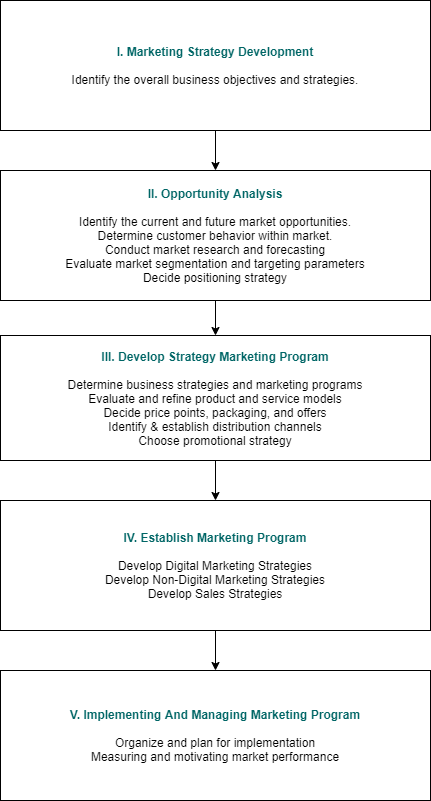Startups, like any other firm, can’t flourish without a solid startup marketing strategy. A well-documented plan for startups explains a company’s strategy for achieving its objectives. In other words, a good marketing plan serves as a road map for a startup’s success.

Startup Marketing Plans Are 100% Necessary
A marketing plan consists of strategies for the promotion of a startup’s products and/or services. It’s important to know, while there is no standard template, it usually includes details, information, timelines, and checklists that serve as the starting point for guiding the marketing process.
Standard marketing plans assist startups in identifying the right customers, media channels, and ways to target them. For most brands, the success of the business is highly dependent on a solid startup marketing strategy that is implemented on time. Marketing plans for startups can help by:
- Determining the efficacy of a startup’s marketing strategy
- Clarifying the market position of services and products
- Understanding your market, competitors, and customers
- Defining a company’s products and services
- Recognizing and implementing various marketing strategies
The Elements of a Startup Marketing Plan
After reviewing hundreds of case studies from different digital marketing agencies for startups, we developed a marketing plan outline that can help you get your business off the ground quickly and easily.
First, customers must be identified.
First and foremost, you need to determine who exactly are your customers in as much in-depth detail as possible. Simon Sinek suggests beginning with “WHY” before moving on to HOW. Determine who your customers are and then develop a startup marketing strategy for them. You should be aware that numerous other startups are selling nearly identical products to yours. So, what is your competitive advantage? First, you must determine which type of consumer you are attempting to reach. Your efforts would be rewarded if you provided a comprehensive description of these categories. Describe the target audience in great detail so that everyone understands the goals you’re trying to accomplish.
For instance, here’s a buyer persona sketch for an e-commerce store selling yoga leggings.

Demographics: Primarily females between the ages of 18 to 28, University and College education, with median income of $40K per year.
Psychographics: Interests include athletics, gymnastics, fitness, yoga, and exercise.
Objectives: To become more attractive and slim.
Purchasing Power: $50-$100
Problems:
- Lacks time to go out and purchase fitness gear from a local store.
- Desires to lose weight quickly
- Wants compression pants that will help lose weight and gain muscle
Follow the Buyer’s Journey
After there is a good understanding of the customer and buyer’s persona, you can begin tracking them to gain additional information about their purchasing habits and preferences. This will uncover the future marketing focus of your startup. It’s important to develop clear and actionable information into how to expand your business further. As a result, it is critical to track the buyer’s journey using various tools and software.
For example, you can use analytics tools to translate website traffic into the buyer’s journey. Google Analytics is a free tool that provides a wide range of tracking options, including purchases, phone calls, and contact form submissions.
Differentiate Yourself From the Competition
The only way to stand out from the crowd is to leverage your unique position. A key component of a startup marketing strategy is by implementing features and benefits that competitors do not offer. Search forums, social media, and other online communities are great places to learn what your customers like and dislike. Then, simply incorporate those features into your offer.

Then promote the features in the same places so that potential customers are aware that you offer these features. A simple yet comprehensive positioning statement of how you will meet the needs of your customers while outperforming the competition can work wonders for you. A positioning statement with a goal-oriented approach to problem-solving is preferable to a skewed vision.
Include Marketing Concepts for Specific Niche Markets
Anyone who is starting a business from the ground up should find a way to give their company an advantage. One of the most important ways for a company to gain a competitive advantage is to identify a market niche where it can best implement promotions to outperform other players in that market segment.
Finding a niche can be challenging. However, owning a specific niche should be one of the primary goals for the business. By researching the details about the niche segment, you can really gain an understanding of the market in which you’re operating, where gaps in the market are, and how to capitalize on the niche segments.
To summarize:
- Look for new trends.
- Experiment with new technology.
- Discover and pursue market opportunities.
- Create novel solutions to a problem.
- Ensure startup marketing strategy is documented before starting.
Selecting Profitable Marketing Channels
When you first start, you will focus on multiple channels, but after a few months of trial and error, you should have identified a few channels that work.
Forbes reports that:
Among the hundreds of marketing channels available (PR, influencers, events, digital, podcasts, print, newsletters, partnerships, and so on), it’s critical to choose the ones that will work the hardest for you for the least amount of money. A good marketing strategy begins with strategically placing bets on a few channels where your customer is most likely to see your message AND take action (like, share, buy, comment, sign up, review).
Forbes
It’s also important to ensure that you’re engaging with customers at every step of the purchasing journey, from brand awareness to customer purchase. Also, be sure to stay in touch with customers after they’ve purchased to nurture brand loyalty and consumer advocacy.

Now, repeat the process.
Stay with your plan once you’ve devised one. Implement the plan for six months and then measure results to understand what worked and what didn’t. There will be times when the strategy does not go as planned; keep track of these instances and monitor your progress. You’ll have gained enough experience after six months to make better-informed decisions in the future.
Marketing Channels for Startups
Now let’s look at tactics for promoting your startup to gain new customers. Aside from the traditional approaches such as radio, print, or broadcast media, we have compiled a shortlist of various communications channels that can help grow your business.
Let’s look at how to use them effectively to make an impact.
Social Media
Social media has especially grown in popularity over the last 15 years, and serves as a good starting point for modern-marketing methods. It has transformed into an essential component of any marketing strategy because it allows you to reach a larger audience without a big investment. By taking a strategic approach, you can concentrate on smaller goals. Use it in conjunction with your other content, such as newsletters, blog articles, influencer collaboration, ebooks, and so on.
Points to remember:
- Test content across all social media channels, but focus on a select few that are successful.
- Post engaging and helpful content that raises brand awareness.
- Assist potential customers by answering their questions in communities and groups.
Search Engine Marketing (SEO)
The majority of digital startups continue to rely heavily on search engines for increasing site traffic and growing revenue over a long-term timeline. They generate traffic organically from search engines like Google through blogging, earned media via public relations, and building backlinks through guest posting. That is why startups should prioritize improving their rankings on search engines, but not rely solely on it. A solid SEO strategy significantly reduces spending while increasing potential ROI.
When you first start with search engine marketing, make sure to:
- Create an effective content plan suited for organic rankings.
- Experiment with high-volume long-tail keywords to generate relevant traffic to your website.
Email Marketing
Whoever said email marketing is dead, is dead wrong! Email marketing continues to be an effective medium of promotion and marketing for most companies. It is also an essential component of a marketing strategy and can be effectively used for retargeting. Email marketing tactics can help businesses expand their reach, and to convert visitors into customers, email marketing necessitates the automation of drip marketing campaigns.
Email marketing is implemented as a way to move visitors from the awareness stage to the conversion and loyalty stages by sending relevant marketing material to customers at different steps of the buying journey.
Startups that want to grow their business through email marketing should:
- A/B test email subject lines, headlines, and content.
- Subscribers can be segmented based on their interests and preferences.
Paid Promotion
Simply put, paid advertising is absolutely crucial to the grow of any business. As a startup, you must first become acquainted with your brand before advertising it to the appropriate audience and target market. You can impress your audience and extend the reach of your business by targeting customer preferences and advertising relevant messages to them. It’s important to ensure that you identify the most effective paid marketing channels for gaining new clients. For example, Facebook marketing strategies like paid ads work great for consumer products but are less effective at driving growth for business-to-business brands.
There exists a degree of uncertainty when it comes to paid marketing and digital advertising. That’s why experts advise that your strategy should not rely solely on paid advertisements as the primary source of inbound traffic. Please keep in mind that paid ads rely on either purchasing intent or impulse purchases. People who use search engines have higher purchasing intent, whereas people who browse social media feeds in their spare time are more likely to make impulse purchases.
Referrals and Affiliates
People frequently affiliate and referral programs confused.
- Affiliates are other businesses that are attempting to make money by promoting your products.
- Referrals are repeat customers who recommend your business to their friends and family.
Obtaining affiliate partnerships for your startup is one of the most effective ways to gain new customers quickly. Affiliate recommendations typically come with more authority, which positively influences people to sign up for your program. From an ROI perspective, you only have to pay your affiliates a commission when someone signs up through their referral link, rather than spending on tactics that drive traffic to your website.
In comparison to paid marketing, affiliate partnerships are a more effective way to acquire customers.
Another effective way to grow sales is through referral marketing. Generally speaking, referrals don’t perform as well as affiliate marketing, but it’s still a good marketing strategy for startups. For instance, companies like Lyft and Uber make excellent use of referral marketing. When someone downloads their app, they receive a message informing them that if someone else uses their coupon to get a ride, they will receive a credit to be used in their app.
Because of the direct impact on increasing profitability, affiliate programs deserve special attention in your startup marketing plan.
Startups can use this marketing strategy to grow their exposure and gain more customers. However, to pull this tactic off successfully, it’s important that customer support is superior. If not, you’ll risk losing your affiliate programs if errors occur with customers sourced from affiliates.
Blogs and Public Relations
Startups should also concentrate on developing content as part of their strategy. This entails developing six-month keyword research, blog marketing, and outreach strategy focused on organic rankings. According to the Content Marketing Institute, blog articles alone are an effective way to raise brand awareness about your product than any other medium. Another benefit of content marketing is you own the content. You don’t know when the social media algorithm will change, or when the paid marketing channel you use to promote your products will increase in price. But you do know your blog will always be working for you, 24/7/365.
Marketing Through Influencers
Influencer marketing is another approach to generate buzz for startups. As a result, it is a critical component of the startup marketing strategy. It entails identifying, collaborating (and most times, paying) a social media influencer to spread your message within their network. Influencer marketing does not guarantee sales, but it is an excellent way to raise brand awareness.
It’s important to remember:
- Influencers can be used to test new products in the market more quickly.
- More ROI can be obtained by utilizing micro-influencers.
- Focus on a variety of micro-influencers to expand your reach.
Offline marketing should not be underestimated.
Digital marketing is absolutely sufficient to spark growth on its own. However, some startups require traditional marketing mediums to succeed. Print media and television marketing, billboard and transit advertisements, event marketing and sponsorship, and guerilla marketing are all examples of offline marketing channels. Because of their impact on effectively growing a brand, these marketing options should be considered when developing a startup marketing plan.
Other examples also include sales brochures, business cards, flyers, and vouchers. Before deciding on the type of offline channel to use, it is critical to first have a deep understanding of your customers.
Marketing Performance Metrics
Now that you’ve determined all aspects of your marketing strategy, it’s time to put your plan into action. Begin by marketing through various social media channels, start broad then narrow your campaigns to a few that work.
Prepare to Make Changes
Lastly, don’t be afraid to change the direction of your campaign to find a successful marketing strategy for your startup. Things have a habit of changing. To meet market demands, all businesses must be ready to change the course to maintain a competitive advantage.
Were you able to use this guide to create a startup marketing plan? What else should we say about it? Let us know by sharing this article on social media and tag us in the post!



























